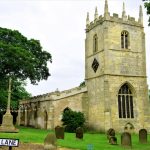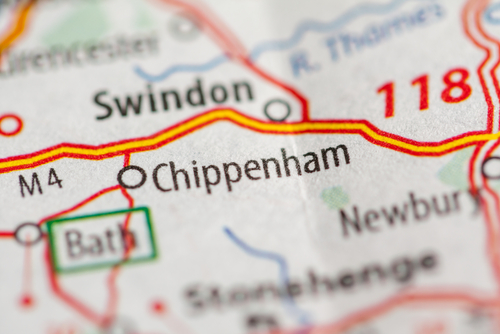
Chippenham in Brief
Chippenham is a market town and civil parish in Northwest Wiltshire in southwest England. It lies approximately 20 miles (32 km) east of Bristol, 13 miles (21 km) northeast of Bath, and 18 miles (29 km) southwest of Swindon on the banks of the River Avon. At the 2011 UK national census, Chippenham had a population of 35,800.
A Fleeting History
Early Times
The Chippenham area is thought to have been first settled before the Roman era. The Romans themselves were also certainly present in and around Chippenham. Recent archaeological finds in the area include burial urns and a farmstead from the period.
Chippenham is thought to have originally been established by Anglo-Saxons at the beginning of the 8th century. Some experts believe that the place name derives from the Saxon word ‘cipan’, meaning ‘to sell’. The Anglo-Saxon Chronicles recorded the name as Cippanhamme, giving rise to a theory that the double ‘p’ indicates the personal name, Cippa. The ‘hamme’ part likely refers to land enclosed by the loop of the river, as opposed to the more common ‘ham’, referring to a dwelling or property.
In the mid-9th century, Alfred the Great claimed the forest around Chippenham as a royal estate and built himself a hunting lodge there. In 878, the invading Vikings successfully besieged the town. However, Alfred retook the town, months later, scoring a decisive victory over the Danes at the Battle of Ethandun.
In 933, the Anglo-Saxon Chronicle recorded that the ‘Witan’ (Parliament) was being held in Chippenham. In 1042, there is a written reference to a church being in the town. In 1086, the Domesday Book recorded that the settlement of ‘Cepen’ had a population of between 600 and 700.
The Normans
During Norman times, the royal estate was divided into three manors i.e. Sheldon, Rowden, and Lowden. In 1205, King John granted Chippenham’s first charter for a weekly market. From the mid-13th century, records show that the town expanded rapidly along Lang Street (now ‘The Causeway’). In 1295, Chippenham was granted confirmation of borough status and the privilege of representation in the English Parliament.
In 1314, King Edward II granted the town a further charter so that an additional market could be held on a Saturday. By the 14th century, there was a road (A4) linking Bristol with London. The link which passed through Chippenham was an important trade route, especially for the wool trade. From the early 15th century, the town’s expansion pushed into the current Newtown area.
Maud Heath
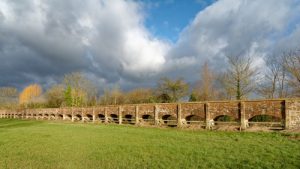
The raised 64-stone arch section of Maud Heath’s Causeway
In 1474, local resident and philanthropist, Maud Heath, bequeathed monies from her will to the town. The money was used to build a raised path over the floodplain of the River Avon between Wick Hill and Chippenham Clift. It enabled locals to make their way to Chippenham market on foot. In time, the path became known as Maud Heath’s Causeway. Still in existence today, the path is now maintained by the local authority. In 1838, Henry FitzMaurice, the 3rd Marquess of Lansdowne, and the Rev. William Bowles, vicar of Bremhill, paid for the erection of a monument to Maud, which is located at the Wick Hill end of the path.
The 16th – 18th Century
In 1554, Queen Mary presented Chippenham with a Royal Charter, confirming the borough status that had been granted by succeeding Saxon, Norman, and Plantagenet kings. She also bequeathed the borough with 217 acres of land and granted the right for it to send two representatives to Parliament. It was also during this time that the wool industry really began to take took, mostly due to the advantage presented by the River Avon as a means of transport.
In the early 17th century, Chippenham was hit particularly hard by several outbreaks of the black plague, causing a recession in the cloth industry and hardship for the town’s population. The wool trade faced further problems during the English Civil War of the mid-17th century, due to a Royal decree that prohibited the sale of cloth to Parliamentarian-controlled London.
Like a number of other Wiltshire towns, Chippenham experienced stagnation during the 17th and 18th centuries, seeing little expansion. The cloth industry did continue in Chippenham but as little more than a cottage industry. In 1747, the town experienced more woes when a bribery and corruption scandal, involving the two elected MPs for Chippenham, led to the spectacular downfall of the once-popular Sir Robert Walpole’s government at the general election.
The 19th Century
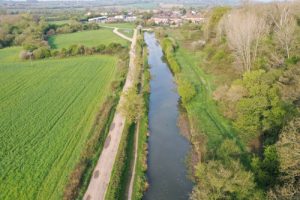
A restored section of the Wilts & Berks Canal
Growth did return to Chippenham at the end of the 18th century due to improvements in connectivity. In 1800, a 6 miles branch from the Wilts and Berks Canal finally reached Chippenham, after a 2 years dispute had seen the construction of the waterway fall short of the town. While the canal did not officially open until September 1810, access to the markets of Bristol and London, via the canal, had an almost immediate effect.
The expansion of the town’s cloth industry came, mainly due to the fact that coal could now be shipped in, enabling the new-fangled steam-powered factories to be built. However, in 1841, the Grand Western Railway from London to Bristol, passing through Chippenham, was completed. The railway took away trade from the canal undermining its commercial success. In 1848, the completion of the Wilts, Somerset and Weymouth Railway, connected the town with Trowbridge and Westbury.
The arrival of the railway attracted new industries to the town especially those in the agricultural sector. By the middle of the 19th century, Chippenham was a major centre for the production of dairy and meat products, which would later encourage the likes of Nestle and Matteson’s to set up shop. Another industry that grew during the mid-19th century was railway engineering. Rowland Brotherhood who made railway wagons, locomotives and bridges, as well as carrying out track maintenance, founded their Chippenham business in 1842.
In 1894, Evan O’Donnell who made railway signalling apparatus also established a business in the town. By 1901, Evans O’Donnell had merged with several of the town’s railway engineering companies to create the Pneumatic, Electric, and General Engineering Company. Other businesses in the town at the turn of the century included butter makers, brewers, a gun cartridge factory, a brick and tile works, and the Royal Wiltshire Bacon Co Ltd.
The War Years
During World War I, a total of 171 servicemen from the Chippenham area were recorded as being killed. In 1919, a council committee decided that the town’s war memorial should be sited in a prominent position in the town, finally deciding on the marketplace. The memorial was unveiled on 4th September 1921.
In 1920, another major merger of railway engineering companies brought the Westinghouse Brake & Signal Co. to Chippenham. In 1923, the John Cole Park opened, a bequest from a local pharmacist and former Town Mayor. In 1930, Chippenham’s cloth industry finally came to an end when Waterford Mill closed down and company operations moved to Stroud.
Early in WW2, evacuees from Kent were sent to Chippenham to escape the potential bombing. In 1940, about half of Chippenham’s working population was employed in engineering, mostly at Westinghouse, which had been identified as a possible Luftwaffe target. While Chippenham mostly escaped WW2 bombing, an odd Luftwaffe plane, which had failed to target Bristol, did drop bombs on the town. In all, there were 5 related war deaths in the town, one being killed in an aircraft accident. Later in the war, American soldiers were stationed in the town, awaiting the D-Day Landings.
From the mid-1900s Chippenham saw great expansion. The early 1950s saw the market move from the town centre to Cocklebury. A housing development was seen at Cocklebury Farm in the late 1950s and at Monkton Park in the 1960s. The building of the western bypass also brought about further town development.
The Modern Era
On 12th February 1998, Chippenham made the headlines of the national news when an unexploded World War II bomb was discovered at Harden’s Mead, leading to 1100 people being evacuated from their houses. The 750 kg German bomb was discovered by builders digging the foundations for a school. Three days later, ‘FatBoy’, as the bomb had been dubbed by local residents, was blown up by the Army in a controlled explosion, allowing evacuees to return to their homes.
While still a market town, with two weekly street markets, Chippenham has gradually shifted to being more of a commuter town for the likes of Bath, Bristol, Swindon and even London. The town’s biggest former employer Westinghouse is now owned by multinational conglomerate Siemens, which undertakes worldwide transport infrastructure projects. One of Europe’s largest logistic companies, Wincanton PLC, is headquartered at Methuen Park in Chippenham, employing more than 20,000 nationally.
Currently, much of the Wilts and Berks canal is undergoing restoration, including the 6-mile (10 km) branch canal to Chippenham. However, the work is being carried out by a volunteer workforce so progress is limited.
Major Festivals
On 17 April 1960, American rock and roller Eddie Cochran was killed in a car crash at Rowden Hill. Twenty-one-year-old Cochran died as a result of his injuries and a memorial plaque was erected near the site. Since the mid-1990s, Chippenham has hosted a 3-day Eddie Cochran festival, usually held in late September or early October.
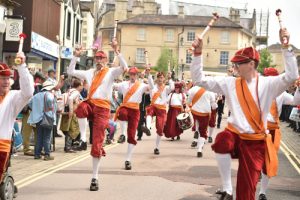
Chippenham Folk Festival is a popular annual event
Since the early 1970s, Chippenham has staged an annual Folk Festival featuring traditional English music, dance, song, and related activities. Usually staged over the Spring Bank Holiday, the 4-day festival is one of the best-supported events of its kind in the country.
Twinning
Chippenham is twinned with La Flèche in France and Friedberg in Germany.
Getting there!
Chippenham lies 4 miles (6 km) south of the M4 motorway, which links the town to Bristol, Swindon, South Wales and London. The A4 former coach road, A420 and B4069 provide further road links to Bath, Bristol and Oxford.
The average journey time between London Paddington and Chippenham is around 2 hours 25 minutes, with 4 trains making the journey, daily. The local train service which serves Melksham, Trowbridge and Swindon is operated by TransWilt.
There are 8 direct buses per day between London Victoria bus station and Chippenham, which are operated by National Express. The journey should take a little over 2.5 hours. The first bus leaves London at 08.30 and the last 23.00. From other parts of the country, it might be easiest to head to Bristol and change bus for Chippenham from there.
The nearest airport is Bristol Airport, which is 30 miles (48 km) west of Chippenham, via the A420, the most direct route.
Notable people
A few notable people who have links to Chippenham are:
- Jeremy Corbyn – a politician who served as Leader of the Labour Party in the opposition between 2015 to 2020. Mr Corbyn was born in Chippenham in 1949.
- Sir Robert Peel (1788 – 1850) – was a prominent politician and statesman who served twice as the UK’s Prime Minister during the mid-19th century. Additionally, he is widely regarded as the founding father of the UK’s modern police force as well as of a major prison reformer. Peel served as MP for Chippenham between 1812 and 1817.
- William Fox Talbot (1800-1877) – was a scientist, inventor, and pioneer in the field of photography. Born in Dorset, he moved to Lacock Abbey as a child and lived his entire life there.
- Eddie Cochrane (1938 – 1960) – a famed American rock and roll singer died in a road accident in Chippenham on 17 April 1960, when he was just 21 years old.
Did you know?
On 7th February 1953, a B-36 bomber from Carswell Air Force Base in Fort Worth, Texas, on a routine training mission to RAF Fairford in Gloucestershire mysteriously crashed at Nethermore Wood, near Chippenham. All 15 of the giant plane crew bailed out safely and there were no civilian casualties. The crash was not widely reported but the story made it into several local papers and a few other domestic publications, which included the Portsmouth Evening News, the Liverpool Echo and the Coventry Evening Telegraph.
According to Dennis R. Jenkins’s book of 2002; Magnesium Overcast: The Story of the Convair B-36, delay in landing at Fairford, caused by short-staffing and inexperienced air traffic controllers, saw the plane run dangerously low on fuel, prompting the pilot to make the momentous decision to abandon the aircraft.

A Convair B-36 bomber – similar to the one that crashed near Chippenham in 1953. Photo credit to US Government @ Wikicommons.
Sport in Chippenham
Chippenham Town FC
Chippenham Town FC is a football team that currently (2020) plays in the National League South, the 6th tier of English football. Nicknamed ‘The Bluebirds’ they play home games at the 3,000-capacity, Hardenhuish Park.
Chippenham RFC
Chippenham Rugby Football Club currently (2020) plays in the South West 1 East League, level 6 in the English rugby union system. They play their home games at Allington Fields.
Chippenham Cricket Club
Chippenham Cricket Club is a well-established organisation that runs 4 senior teams and 4 junior teams. The first XI play in the Gloucester & Wiltshire Div. 1 League. They play their home games at the shared facility of Hardenhuish Park.
Things to see and do!
Some of the things to see and do in and around Chippenham are;
- Chippenham Museum – is housed in the 18th-century former magistrates’ court. Exhibitions, guided walks and talks by local historians help tell the story of the town’s history, including its links to historical figures.
- Corsham Court – is an exceptional country house, 5 miles from Chippenham in the village of Corsham. The famed Capability Brown designed the gardens and house extension in the mid-19th century. The gardens also contain a ruined folly.
- Lacock Village – is four streets of a preserved 18th-century village owned by the National Trust. The village, which is located 3.5 miles from Chippenham, has provided a shooting location for some of the Harry Potter films, Downton Abbey, a BBC adaption of Pride and Prejudice, and others.
- Lacock Abbey – is a quirky country house with monastic roots. It’s been extended several times so been built in various architectural styles but dates back to the 13th century. It’s located in the centre of Lacock village, set in its own woodland grounds on the banks of the Avon. The Abbey has various art displays and exhibitions. There’s also a shop and cafe on site.
- Fox Talbot Museum – can be found in the grounds of Lacock Abbey and is dedicated to the memory of William Henry Fox Talbot (1800-1877). Arguably the Abbey’s most famous resident, Talbot is renowned for his contribution to photography. The various displays at the museum are centred around Fox’s life’s work.
- Maud Heath’s Causeway – is a 15th-century 4.5-mile long pathway that runs between Wick Hill and Chippenham, crossing the River Avon. Particular points of interest on the walk are the high stone column monument erected to Maud and a 64-stone arch raised section along the river, which are Grade II Listed by National Heritage.
- Bowood House and Gardens – is a grade I listed building dating from the Georgian era. While most of the house was demolished in the 1950s, the 2,000-acre gardens were designed and laid out by famed landscape gardener Capability Brown in the 1760s. Bowood is about 6.5 miles from Chippenham on the way to Calne.
Where to stay?
There’s a very limited amount of accommodation in Chippenham itself. Staying further afield will obviously give you more options. A rough guide to prices for 2 adults sharing, staying in the general area (5 miles or less) of Chippenham is between £70 – £150 per night for either a guesthouse or hotel, depending on standard and location.
Moving to Chippenham?
Thinking of moving to Chippenham? The average selling price for all property in Chippenham for the year up to August 2020 was approximately £238,500. This represents a rise of about 1% in the previous 12 months. In terms of property types, flats sold for £143,000, terraced houses for £193,900, and semi-detached for £231,000.
Note: Photos and images credited as indicated and/or Shutterstock.com

